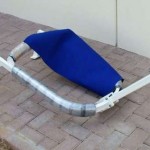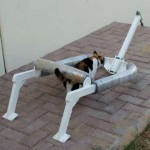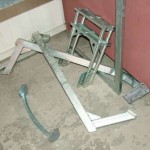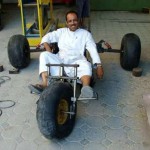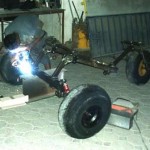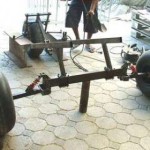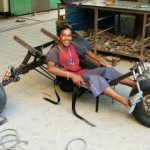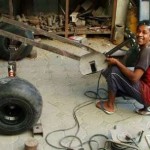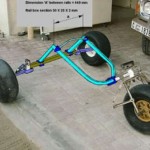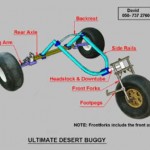Making the Ultimate Desert Buggy
I designed, built the UDB (Ultimate Desert Buggy) & gave it its virgin ride yesterday in some small dunes near my house.
New Buggy has been built to:
1) Take hard downward forces, hence the rectangular box section side rails & rear axles.
2) Has PL style rear suspension although I have changed the angles from the PL design.
3) Rear bigfoots mounted on wide offset rims.
4) Have mounted seat quite high up to cleared sand ridges. This is an Eliot seat with long straps, so can lower the seat if I ever move to flat country.
5) Rear wheel centres are 1.67m
6) Buggy made mainly of mild steel, zinc coated & then painted (80micron coat).
7) The tubes for headstock & rear suspensions bearings & front axles were made from stainless.
8) I use 20mm axle bolts (Grade 10.90 & front axle is 15 mm dia.
9) I have clamped the rear axle & backrest (curved tie bar) to the side rails using M8 Allen screws. These areas, which I have welded on other buggies in the past, have been a source of trouble with cracking. I hope by eliminating the welds here, I will have a trouble free buggy.
10) The buggy is a bit heavier than what I would like (didn’t weigh it but think it’s around 50+ kgs). I decided to sacrifice weight for strength when designing it. I also wanted to have rear suspension (adds weight) to eliminate much of the shock when transitioning from a steep sand wall to the floor below.
11) Everything is new except for the split rim cast alloy front wheel. A bigfoot tyre on this rim makes it a bigfoot light. I had three of these old rims lying around & used one on an earlier buggy (DBI). That’s why it’s painted that awful yellow colour
12) I used the bag from DBI, which is Libre buggy bag.
How does it ride?
First noticeable thing, being a bit higher up than my other buggies, it felt a bit strange. The side rails could have been about 10 to 15 mm closer. I just didn’t measure myself right when designing the buggy.
I could not believe the comfort. I think I have finally got it right, although I still have to make some small adjustments like moving the downtube a bit more forward. I think the buggy weight improves the comfort because it doesn’t bounce around so much. The rear shocks have an adjustment on the springs as well as the shocks. I guess I must have set this up right. The position of the backrest is adjustable but didn’t need to move this.
I could ride through the dunes without problems & no dragging of seat as I traversed the ridges. It stayed very stable even when moving at steep sideways angles.
I did 45 kms and a top speed of only 48 kph (not the most exiting wind yesterday) during its first ride & it all held together well.
The wind looks good out there right now so off I go again.
This afternoon was the UDB’s second day out. I banged off 87 km (top speed just 49 kph). I had it bouncing severely over some rough bumpy ruts. I also ran it through the dunes & plonked it down quite hard a few times. Good news is that nothing broke or bent on the buggy. I had a buckle break on my Dakine harness, which I can live with.
Obviously a lighter buggy will climb the dunes easier but you have to put all moving the mass into perspective. July before last, I weighed 103 kgs (obese). I took myself in hand & got my weight to an acceptable 83 kgs.
That’s 20kgs less to drag up a dune. A 30kg buggy will go up much easier but then it will break much easier. Some of my mates have a combined buggy & body weight less than me & will typically fly a smaller kite. e.g. Today, I was flying my 6.6 Blade. My mate about 80kgs was riding his reinforced PL comp (lighter buggy) but was flying his 4.9 Blade. I was quicker over the sabkhas and could negotiate the dunes easier than him but there again I’m more practiced than him. I would say that on being pulled up a dune it was neck & neck.
There is a lot of technique to dune buggying and although a lighter buggy would be better, believe me they break a lot easier. You name it & I’ve broken it.
For pure bending & shear forces, the rectangular or square section has a better second moment of area compared to round, Whereas in torsional loading, box section is poor compared to round tubular section. Look on any 4 X 4 that has a chassis & they all use rectangular section.
Funnily enough, the part of the buggy that appears to have the most torsional loading on a buggy is the downtube & here we typically see box section being used. I have badly twisted a down tube in the past (pics). I made a repair using a round section. (pic) The downside to using round section for the down tube is that it makes it that more complicated to fix to the side rails. Cutting it to fit the round head stock wasn’t a problem.
Even with the adjustment holes (still PL concept), I found the down tube too long, so cut it and put a collar over the tube for additional security as I don’t trust the welding (pic). I’m struggling to find a good welder here. Later, I found the rake angle too steep & put a small bend in the tube (can’t find a pic of that mod.). to reduce it.
The loading on a buggy is variable, cyclic & complex. If we knew exactly what it was, we could put together some kind of finite stress analysis programme to work out the optimum sized sections. Side rails are also subject to some torsional loading & the use of round tube for side rails for flat land buggying is ideal but as mentioned earlier, I do drop the buggy down hard and the dynamic bending loads are proportionaly much higher than what your average flatland buggiers experience.
Freestyle buggying can also put some severe loading on a buggy but the criteria for these guys are very light buggies i.e. short axles, no suspension, smaller tyres etc. They still have to be strong but the size does allow for considerable weight reduction.
I’m not mad about white paint but had the paint spraying done for free. I work for the local Caterpillar dealer here and they have Cat yellow and didn’t want my buggy looking like a bulldozer (still have a Cat yellow front wheel). They also have white because we sell a lot of Cat marine engines & our power generation rental fleet has white enclosures. They don’t have any other colour. Glare isn’t a problem. I have more of a problem when the kite is flying in the sun. I wear strong dark wrap around glasses but they don’t offer enough protection.



